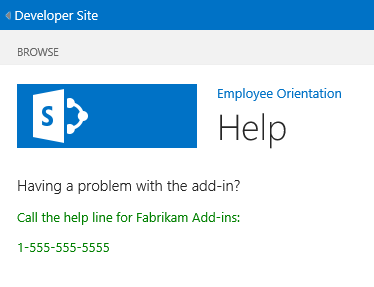Note
Access to this page requires authorization. You can try signing in or changing directories.
Access to this page requires authorization. You can try changing directories.
Important
The SharePoint Add-In model in SharePoint Online has been deprecated as of November 27th 2023, checkout the full retirement announcement to learn more.
Deprecation means that the feature will not get any new investments, but it's still supported. SharePoint add-in model is retired fully on April 2nd, 2026 and is no longer available after that time. Primary replacement technology for the SharePoint add-in model is SharePoint Framework (SPFx) which continues to be supported also in future.
This is the seventh in a series of articles about the basics of developing SharePoint-hosted SharePoint Add-ins. You should first be familiar with SharePoint Add-ins and the previous articles in this series, which you can find at Get started creating SharePoint-hosted SharePoint Add-ins | Next steps.
Note
If you have been working through this series about SharePoint-hosted add-ins, you have a Visual Studio solution that you can use to continue with this topic. You can also download the repository at SharePoint_SP-hosted_Add-Ins_Tutorials and open the BeforePage.sln file.
In this article, you add a help page to the Employee Orientation SharePoint Add-in and configure it to use a custom CSS stylesheet.
Add a page
In Solution Explorer, right-click the Pages folder and select Add > New Item. The Add New Item dialog opens to the Office/SharePoint node.
Select Page and give it the name Help.aspx.
Find the two asp:Content elements in the file, and add the following third asp:Content markup in between them.
<asp:Content ContentPlaceHolderID="PlaceHolderPageTitleInTitleArea" runat="server"> Help </asp:Content>Find the asp:Content element with the ID of PlaceholderAdditionalPageHead, and add the following markup to it.
<link rel="Stylesheet" type="text/css" href="../Content/App.css" />Find the asp:Content element with the ID of PlaceHolderMain, and remove any child elements in it.
Add the following as content to the same asp:Content element.
<H3>Having a problem with the add-in?</H3> <p>Call the help line for Fabrikam Add-ins:</p> <p>1-555-555-5555</p>Save and close the file.
Open the Default.aspx file.
Find the asp:Content element with the ID of PlaceHolderMain, and then add the following markup to the end of it.
<p><asp:HyperLink runat="server" NavigateUrl="JavaScript:window.location = _spPageContextInfo.webAbsoluteUrl + '/Pages/Help.aspx';" Text="Get help for the Employee Orientation add-in" /></p>Save and close the file.
Add a style class to the stylesheet
In Solution Explorer, open the app.css file in the Contents folder, and then add the following line to the file.
p {color: green;}Save and close the file.
Run and test the add-in
Use the F5 key to deploy and run your add-in. Visual Studio makes a temporary installation of the add-in on your test SharePoint site and immediately runs the add-in.
When the add-in's default page opens, select the Get help for the Employee Orientation add-in link to open the Help page.
Your custom page opens and the two lines that you put in
<p>tags are green.Figure 1. Help page

To end the debugging session, close the browser window or stop debugging in Visual Studio. Each time that you select F5, Visual Studio will retract the previous version of the add-in and install the latest one.
You will work with this add-in and Visual Studio solution in other articles, and it's a good practice to retract the add-in one last time when you are done working with it for a while. Right-click the project in Solution Explorer and select Retract.
Next steps
In the next article in this series, you'll add custom client-side rendering to a SharePoint-hosted SharePoint Add-in.